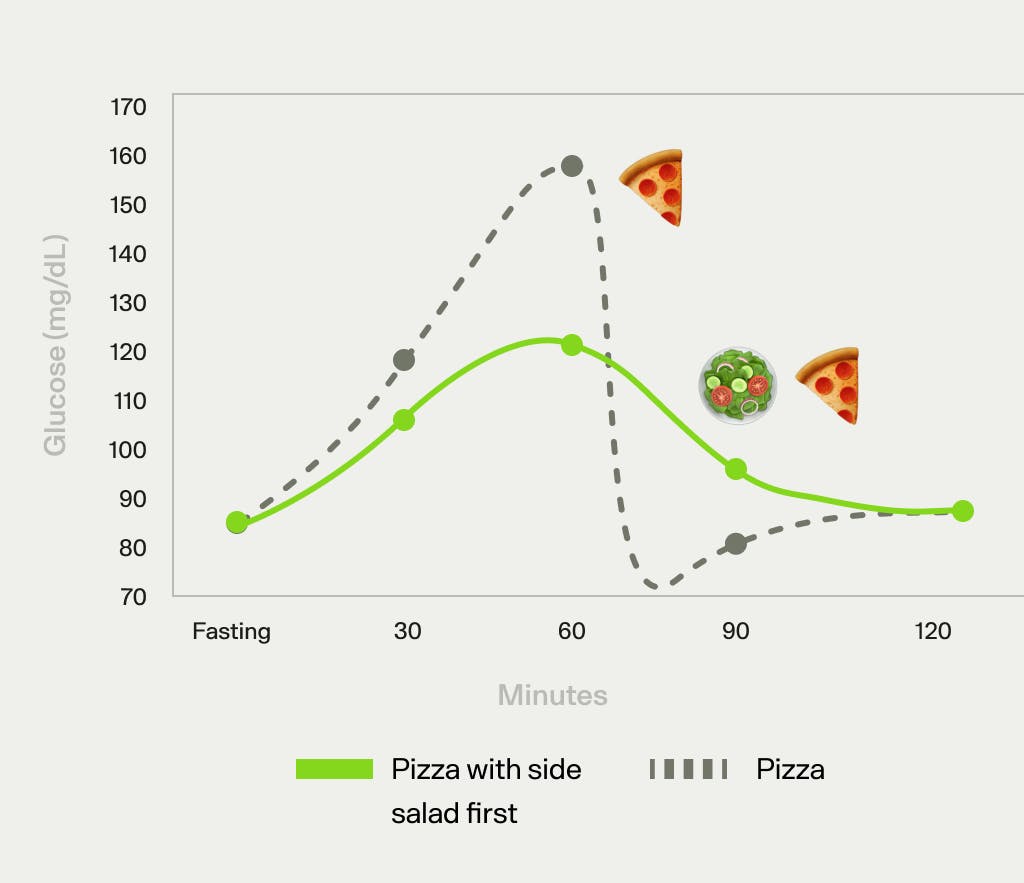If you’ve never paid much attention to your dietary fiber intake, you’re not alone: research shows that only 7% of Americans met the recommended amount of daily fiber in 2021 [1]. But why is fiber — a type of carbohydrate that your body can’t even digest — so important, anyway? Does it have any benefits? And is there a connection between fiber deficiency and your overall metabolic health?
We’ll walk through the basics of fiber, including the two different types (soluble and insoluble), its effects on your gut health and blood glucose levels, and why eating more of it may be a key part of metabolic healthiness.
What is dietary fiber?
Dietary fiber is a type of carbohydrate found in plant foods that your body can’t digest.
Most carbohydrates, which are long sugar chains, get broken down into glucose, your body’s preferred energy source. Glucose powers the functions that keep you alive, and your body has intricate processes that can turn protein and fat into glucose when your body is running low.
Fiber, on the other hand, passes through your digestive tract unchanged. Like other carbs, fiber is made up of glucose — except in this case, the glucose is trapped inside of tough cell walls that your body can’t break down. That’s because the human digestive tract doesn’t have the specific enzymes that are needed to digest fiber and transform it into energy. (Grazing animals like cows, on the other hand, have entire colonies of bacteria in their gut that produce these enzymes.)
Even though it can’t be digested, fiber still performs a number of critical metabolic functions as it moves through your body, including stabilizing your glucose levels.
The benefits of dietary fiber for metabolic health
Fiber doesn’t just keep your stool intact and feed the good bacteria in your gut — it has powerful benefits for your metabolic health that can help you keep your blood sugar levels stable, curb inflammation, and support your weight management efforts.
Blood sugar and insulin sensitivity
Typically, carbohydrates — especially refined or processed carbohydrates — result in a large blood sugar spike, as your bloodstream is flooded with glucose that needs to enter your cells (with the help of insulin) in order to become ATP, or energy. (ATP is like a battery that provides energy to power the metabolic reactions that keep you alive.)
We also know that experiencing too many large spikes and crashes over time (known as high glucose variability) puts a strain on your pancreas and forces it to overproduce insulin to keep your glucose levels in a healthy range. Over time, this can lead to insulin resistance — where your cells stop responding to insulin, leading to chronically high glucose and insulin levels — as well as Type 2 diabetes and other cardiometabolic health issues.
Soluble fiber — which is any fiber that can be dissolved in water to form a kind of gel — doesn’t cause a spike in blood glucose levels because it can’t be digested [2]. Research even indicates that it’s able to slow down your post-meal blood sugar response and minimize a severe spike [3]. In fact, a meta-analysis of the relationship between fiber and glycemic response found there’s a significant reduction in fasting blood glucose levels after 8 weeks of consistent fiber consumption [4].
What does this mean? Eating a mix of both fibers with your meals — especially if there are other carbohydrates involved — can help prevent you from spiking and crashing and prevent the onset of long-term metabolic health issues.

Gut health and microbiome
Your gut microbiome comprises microorganisms that play a major role in digesting your food, supporting your immune system, and protecting your body from harmful bacteria, among other functions. As scientists have recently begun to uncover, poor microbiome health is associated with a range of chronic illnesses, including metabolic and cardiovascular diseases [6]. And although more research is needed, scientists have also found that a lack of good microbiota may even disrupt intestinal permeability (i.e., how “leaky” your intestines are), which can contribute to inflammation and insulin resistance.
On the other hand, nourishing a diverse range of good microbes in your gut may be able to prevent the onset of these metabolic health issues. Fiber can actually regulate the composition of your microbiome, feeding the good bacteria and allowing them to grow and expand their presence in your digestive tract (as opposed to bad bacteria), as well as maintain the sturdiness or integrity of your intestinal lining — helping to prevent insulin resistance associated with a leaky gut [7, 8].
More importantly, fiber can improve your body’s ability to regulate glucose by changing your gut bacteria. A study where twins consumed identical meals found that the microbiome is a significant factor (apart from macronutrient profile) in determining postprandial glucose response [9].
This may occur because consuming prebiotics (high-fiber foods) produces short-chain fatty acids, or SCFAs, in your colon. Fascinatingly, SCFAs play a number of important roles in your body, one of which is reducing blood glucose levels and even mitigating insulin resistance [10].
Additionally, introducing healthy bacterial colonies in your gut by eating probiotic-rich foods can also help lower blood glucose levels. One study found that obese individuals who consumed the probiotic Bifidobacterium for 2 weeks saw improved glucose regulation [11].
Weight management
If you’re trying to lose weight, you may be practicing a “calories in, calories out” approach where you restrict your caloric intake and exercise more to burn off calories. But calorie tracking alone isn’t sustainable for a number of reasons, and it doesn’t address the bottom line issue for many people: unregulated glucose levels that promote sugar cravings, lead to energy crashes, and trigger a vicious cycle of weight gain that’s hard to break.
Fiber is a powerful tool in helping you address this root cause of unmanageable weight gain by helping you stabilize your blood sugar levels — the first step to hopping off the glucose roller-coaster and improving your metabolic health.
Though research in this area is still relatively new, what we do know is that eating more fiber can help stabilize your glucose — which in turn can help maintain healthy levels of leptin and ghrelin, the hormones that regulate appetite and hunger. Focusing on high-fiber foods is also a great way to consume more whole foods in general, since foods that are rich in fiber tend to be colorful vegetables, low-glycemic fruits, nuts, and whole grains.
How much fiber should I get every day?
The amount of fiber you should eat every day depends on your age and gender. Women under 50 years old should eat around 25 grams per day, while men should eat 38 grams [14]. If you’re above 50, you should aim to get 21 grams (women) and 30 grams (men). Other guidelines pin the daily amount at about 25-35 grams for everyone under 70 [15].
And while there’s no official ratio of how much soluble fiber you should eat compared to insoluble fiber, aiming for at least a quarter (roughly 6-10 grams) of your daily total fiber intake is a good benchmark to keep in mind, and eating both kinds of fiber at every meal has benefits for your metabolic health. A lot of foods that are rich in fiber contain both — which is one of the reasons that getting fiber primarily from food sources, rather than supplements, is always ideal.
How to get more fiber in your diet
If you’re trying to increase your fiber intake and don’t know where to start, here are a few easy ways:
- Eat more vegetables and fruits, especially leafy, colorful produce like cabbage, kale, carrots, and sweet potato, or raspberries, blackberries, unpeeled apples, and passion fruit. Most fruits and vegetables are great natural sources of fiber — and, as a bonus, contain plenty of antioxidants and phytonutrients to support your immune system.
- Foods that are rich in insoluble fiber include bran from oats, whole wheat, and brown rice; peas; berries, including raspberries and blackberries; green beans; cauliflower; leafy green vegetables; unpeeled apples; and nuts.
- Foods that are rich in soluble fiber include beans,, flaxseeds, sweet potato, avocado, brussels sprouts, and legumes.
- Add a tablespoon of chia seeds or flaxseeds to yogurt, salads, and other meals. One tablespoon of chia seeds contains almost 5 grams of fiber (2.8 grams in a tablespoon of flaxseeds). Remember to drink plenty of water with chia and flax, since these forms of fiber need water to create a gel that passes through your digestive system. (If you don’t drink enough water, they’ll pull water from other sources in your digestive tract, which can cause constipation.)
- Snack on raw vegetables and hummus, which is made from chickpeas, a fiber-rich legume.
Fiber experiments: Key Takeaways
Eating more fiber is great for your metabolic health, but experimenting with your food order (i.e., the timing of your fiber intake in relation to your meals) can be a powerful way to understand how your individual biology is affected by fiber intake.
While you don’t need a CGM to try the tips below, doing so can empower you with real-time data that shows you exactly how your blood glucose levels respond to an increase in fiber intake or strategic food order.
- Eat 5-10 grams of fiber 15 minutes before you eat other carbs (especially if they’re starchy or refined) and macronutrients. These can be a fiber-rich salad, an appetizer of raw vegetables and hummus, or even a fruit and a handful of nuts.
- Compare the effects on your blood glucose when you drink a smoothie made of whole fruits, vegetables, and a fat source vs. the same smoothie that has added chia seeds or flaxseeds.
- If you’re making rice or potatoes, which can lead to a glucose spike, let it cool completely before reheating to increase its resistant starch content. Resistant starches act as fiber and nourish your good gut bacteria and have a lower glycemic index. (If you don’t have time to let it cool and reheat, try eating a fiber-rich vegetable, like broccoli, before eating the starch.)
References:
- https://nutrition.org/most-americans-are-not-getting-enough-fiber-in-our-diets/
- https://pubmed.ncbi.nlm.nih.gov/1663443/
- https://pubmed.ncbi.nlm.nih.gov/18287346/
- https://www.sciencedirect.com/science/article/pii/S1756464621001493
- https://academic.oup.com/jn/article/148/1/7/4823705
- https://www.nature.com/articles/s41430-021-00991-6
- https://www.ncbi.nlm.nih.gov/pmc/articles/PMC8153313/
- https://www.ncbi.nlm.nih.gov/pmc/articles/PMC7146107/
- https://www.nature.com/articles/s41591-020-0934-0
- https://www.ncbi.nlm.nih.gov/pmc/articles/PMC9181475/
- https://link.springer.com/article/10.1007/s12088-020-00888-1
- https://pubmed.ncbi.nlm.nih.gov/23885994/
- https://pubmed.ncbi.nlm.nih.gov/31174214/
- https://www.health.harvard.edu/blog/should-i-be-eating-more-fiber-2019022115927
- https://my.clevelandclinic.org/health/articles/14400-improving-your-health-with-fiber

